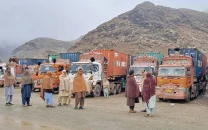Pakistan’s water crisis
Scientific and empirical evidence show water scarcity could put critical stress on economy and society of Pakistan.

The problem of water scarcity in the Indus basin is predicated partly on the inherent limitations of water supply in the Indus River System and partly on the growing water demand associated with inefficient water use in the process of economic and population growth. Unsustainable development practices have exacerbated the problem with intrusion of salinity into the ground water, contamination of aquifers with harmful chemicals such as fluoride and arsenic and pollution of surface water due to lack of an institutional framework for environmentally safe disposal of urban and industrial waste. An important dimension of the water issue in the years ahead is the phenomenon of climate change, which could take the crisis to a critical level.
Water scarcity can be measured by the availability of water compared with the generally accepted minimum per capita requirement of 1,700 cubic metres per person per year. In their book, Freshwater Under Threat: South Asia, Mukand S Babel and Shahriar M Wahid have estimated that the per capita availability of water in the Indus basin is 1,329 cubic metres per capita per year. This is significantly below the threshold requirement. Another interesting indicator of the water problem is the measure of development pressure on water resources, which is the percentage of available water supply relative to the total water resources. This ratio is as high as 89 per cent for the Indus basin compared to only 15 per cent for the Ganges-Brahmaputra-Meghna (GBM) basin. This indicates the relatively greater development pressure on the Indus basin.
Worse, the utilisation of water for production is also highly inefficient by global standards. Water use efficiency is measured in terms of the GDP per unit of water used. In the case of the five top food producers in the world (Brazil, China, France, Mexico and the US) the water use efficiency is $23.8 per cubic metre. The figure is as low as $3.34 for the Indus basin.
The problem of water scarcity is expected to become more acute in the future due to the adverse impact of climate change. Dr Leena Srivastava, in a recent research paper, provides evidence to show that some of the Himalayan glaciers are melting more rapidly than the global average and this could increase the frequency of floods in the short run and increase water shortages in the long term by reducing river flows in South Asia. Furthermore, according to the UN’s Intergovernmental Panel on Climate Change report, given the sensitivity of existing seeds to heat, global warming could result in a 30 per cent reduction in the yield per acre of food crops in South Asia.
Science and empirical evidence make clear that existing water scarcity, when combined with the impact of climate change, could place critical stress on the economy and society of Pakistan in particular and South Asia in general: major food shortages, increased frequency of natural disasters, large scale dislocations of population and destabilising contention between upper and lower riparian regions.
Effective management of this crisis in Pakistan requires close cooperation with India in joint watershed management, increasing the efficiency of irrigation and water use, joint development of technologies, sustainable agriculture practices and institutional arrangements to manage food shortages as well as natural disasters. When faced with a common threat, ideology must be replaced by rationality in the conduct of governance. If we fail to do so, natural disasters could trigger the man-made catastrophe of war.
Published in The Express Tribune, August 16th, 2011.













COMMENTS
Comments are moderated and generally will be posted if they are on-topic and not abusive.
For more information, please see our Comments FAQ